View in other NatureServe Network Field Guides
NatureServe
Montana
Utah
Wyoming
Idaho
Wisconsin
British Columbia
South Carolina
Yukon
California
New York
Wyoming Indian Paintbrush - Castilleja linariifolia
Native Species
Global Rank:
G5
State Rank:
S3S4
(see State Rank Reason below)
C-value:
Agency Status
USFWS:
USFS:
BLM:
External Links
State Rank Reason (see State Rank above)
Castilleja linariifolia is a widespread and common species of the Intermountain Region in the U.S. The northern edge of its distribution comes into the south-central portion of Montana. Observations since the 1970's have expanded its Montana range; however, those found in more northern portions of Montana may be mis-identified species. Verified specimens of Wyoming Indian Paintbrush are found in relatively common habitat types, such as grasslands, sagebrush steppe, and woodlands. Threats have not been identified. Current information on locations, populations sizes, and threats are needed from observers that have carefully examined their plants with the appropriate botanical resources.
- Details on Status Ranking and Review
Range Extent
ScoreF - 20,000-200,000 sq km (~8,000-80,000 sq mi)
Comment99,892 square kilometers
Area of Occupancy
ScoreE - 26-125 4-km2 grid cells
CommentPlant occurs in 55 of the 30,590 4x4 square-kilometer grid cells that cover Montana.
Number of Populations
ScoreC - 21 - 80
Comment80 observations
Environmental Specificity
ScoreC - Moderate. Generalist or community with some key requirements scarce
Threats
ScoreD - Low
General Description
PLANTS: A tall hemi-parasitic, herbaceous perennial that arises from a branched caudex. Plants grow 15-50 cm tall, are sometimes branched from the base, and are glabrous or with short hairs (puberulent). This plant is notable among the paintbrushes for its diffuse ‘open’ form.
LEAVES: Arranged alternately on the stem. Leaves 2–6 cm long, linear to linear-lanceolate in shape, entire or upper leaves sometimes will have a pair of linear lobes. Leaves may be glabrous or puberulent.
INFLORESCENCE: A dense, terminal, bracteate spike with villous to tomentose hairs. The inflorescence tends to be less than 10 cm long while in flower, but elongates as fruits develop. Bracts become colorful, red to orange. The lobes of the floral bracts tend to be narrow, with two long lateral lobes arising from the lower portion of the central lobe. The long calyx (18-28 mm) is unequally lobed. The bottom half is deeply lobed (10-19 mm) while the upper is lobed less (2-8 mm), and together the two lobes tend to curve strongly upwards. Thus, the primary clefts of the calyx are much deeper adjacent to the lip of the corolla. The ultimate calyx lobes are 1-3 mm long and acute. The very long corolla (24-40 mm) is divided almost equally into two parts. The lower tubular portion is about 12-20 mm long, while the narrow hooded upper portion (galea) is about 10-24 long. the lower lip is about 1-2 mm long. The corolla exceeds the calyx and tends to almost lean downwards out of the cleft between the lower calyx lobes.
Sources: Giblin et al. [eds.] 2018; Holmgren in Intermountain Flora 1984.
Diagnostic Characteristics
Castilleja is a difficult genus because hybridization and allopolyploid speciation (containment of multiple sets of chromosomes that are derived from different species) fuzz a species’ characteristics (Giblin et al. [eds.] 2018).
To identify
Castilleja species, it is important to (Giblin et al. [eds.] 2018):
* note colors of the bract, calyx, and corolla while in the field, and
* press many bracts, calyces, and corollas separately to show their shapes.
Castilleja linariifolia and
Castilleja crista-galli can be mistaken for one another. It is speculated that
Castilleja crista-galli is a hybrid product of
Castilleja linariifolia x
Castilleja miniata, because it can exhibit intermediate morphology. Studies are needed.
Wyoming Indian Paintbrush –
Castilleja linariifolia, native:
* Inflorescence bracts yellow to orange.
* Flowers become more widely separated at maturity (than does
C. crista-galli)
* Calyx is conspicuously more deeply cleft on the side adjacent to the corolla lip than on the back. Calyx is curved back.
* Calyx lobes are acute.
Greater Red Indian Paintbrush –
Castilleja crista-galli, native:
* Inflorescence bracts are bright red.
* Primary calyx lobes are cleft deeper in front than in the back.
* Calyx lobes are acute to acuminate.
Species Range
Montana Range
Range Descriptions
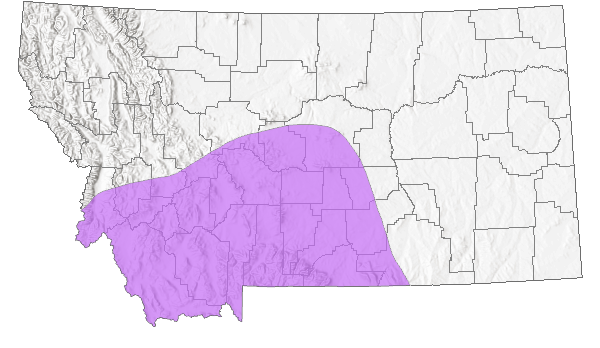
 Native
Native
Range Comments
Oregon to Montana south to California, Arizona, and New Mexico (Lesica et al. 2012).
Observations in Montana Natural Heritage Program Database
Number of Observations: 98
(Click on the following maps and charts to see full sized version)
Map Help and Descriptions
Relative Density
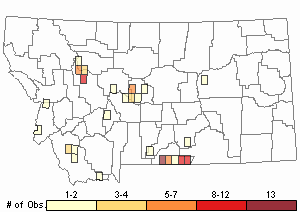
Recency
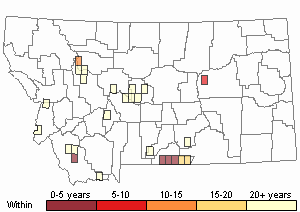
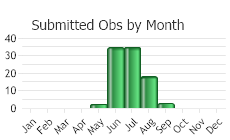
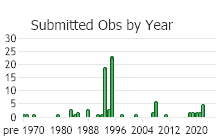
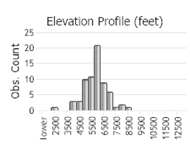 (Observations spanning multiple months or years are excluded from time charts)
(Observations spanning multiple months or years are excluded from time charts)
Habitat
Grasslands, sagebrush steppe, talus slopes, and coniferous woodlands in the montane zones of Montana (Lesica et al. 2012).
Ecology
POLLINATORS The following animal species have been reported as pollinators of this plant species or its genus where their geographic ranges overlap:
Bombus appositus,
Bombus bifarius,
Bombus fervidus,
Bombus flavifrons,
Bombus melanopygus,
Bombus sylvicola,
Bombus occidentalis, and
Bombus kirbiellus (Macior 1974, Thorp et al. 1983, Bauer 1983, Mayer et al. 2000, Wilson et al. 2010, Pyke et al. 2012, Koch et al. 2012, Miller-Struttmann and Galen 2014, Williams et al. 2014).
Stewardship Responsibility
References
- Literature Cited AboveLegend:
 View Online Publication
View Online Publication Bauer, P.J. 1983. Bumblebee pollination relationships on the Beartooth Plateau tundra of Southern Montana. American Journal of Botany. 70(1): 134-144.
Bauer, P.J. 1983. Bumblebee pollination relationships on the Beartooth Plateau tundra of Southern Montana. American Journal of Botany. 70(1): 134-144. Cronquist, A., A.H. Holmgren, N.H. Holmgren, J.L. Reveal, and P.K. Holmgren. 1984. Intermountain Flora: Vascular Plants of the Intermountain West, U.S.A. Vol. 4, Subclass Asteridae (except Asteraceae). Bronx, NY: New York Botanical Garden. 573 pp.
Cronquist, A., A.H. Holmgren, N.H. Holmgren, J.L. Reveal, and P.K. Holmgren. 1984. Intermountain Flora: Vascular Plants of the Intermountain West, U.S.A. Vol. 4, Subclass Asteridae (except Asteraceae). Bronx, NY: New York Botanical Garden. 573 pp. Hitchcock, C.L. and A. Cronquist. 2018. Flora of the Pacific Northwest: An Illustrated Manual. Second Edition. Giblin, D.E., B.S. Legler, P.F. Zika, and R.G. Olmstead (eds). Seattle, WA: University of Washington Press in Association with Burke Museum of Natural History and Culture. 882 p.
Hitchcock, C.L. and A. Cronquist. 2018. Flora of the Pacific Northwest: An Illustrated Manual. Second Edition. Giblin, D.E., B.S. Legler, P.F. Zika, and R.G. Olmstead (eds). Seattle, WA: University of Washington Press in Association with Burke Museum of Natural History and Culture. 882 p. Koch, J., J. Strange, and P. Williams. 2012. Bumble bees of the western United States. Washington, DC: USDA Forest Service, Pollinator Partnership. 143 p.
Koch, J., J. Strange, and P. Williams. 2012. Bumble bees of the western United States. Washington, DC: USDA Forest Service, Pollinator Partnership. 143 p. Lesica, P., M.T. Lavin, and P.F. Stickney. 2012. Manual of Montana Vascular Plants. Fort Worth, TX: BRIT Press. viii + 771 p.
Lesica, P., M.T. Lavin, and P.F. Stickney. 2012. Manual of Montana Vascular Plants. Fort Worth, TX: BRIT Press. viii + 771 p. Macior, L.M. 1974. Pollination ecology of the Front Range of the Colorado Rocky Mountains. Melanderia 15: 1-59.
Macior, L.M. 1974. Pollination ecology of the Front Range of the Colorado Rocky Mountains. Melanderia 15: 1-59. Mayer, D.F., E.R. Miliczky, B.F. Finnigan, and C.A. Johnson. 2000. The bee fauna (Hymenoptera: Apoidea) of southeastern Washington. Journal of the Entomological Society of British Columbia 97: 25-31.
Mayer, D.F., E.R. Miliczky, B.F. Finnigan, and C.A. Johnson. 2000. The bee fauna (Hymenoptera: Apoidea) of southeastern Washington. Journal of the Entomological Society of British Columbia 97: 25-31. Miller-Struttmann, N.E. and C. Galen. 2014. High-altitude multi-taskers: bumble bee food plant use broadens along an altitudinal productivity gradient. Oecologia 176:1033-1045.
Miller-Struttmann, N.E. and C. Galen. 2014. High-altitude multi-taskers: bumble bee food plant use broadens along an altitudinal productivity gradient. Oecologia 176:1033-1045. Pyke, G.H., D.W. Inouye, and J.D. Thomson. 2012. Local geographic distributions of bumble bees near Crested Butte, Colorado: competition and community structure revisited. Environmental Entomology 41(6): 1332-1349.
Pyke, G.H., D.W. Inouye, and J.D. Thomson. 2012. Local geographic distributions of bumble bees near Crested Butte, Colorado: competition and community structure revisited. Environmental Entomology 41(6): 1332-1349. Thorp, R.W., D.S. Horning, and L.L. Dunning. 1983. Bumble bees and cuckoo bumble bees of California (Hymenoptera: Apidae). Bulletin of the California Insect Survey 23:1-79.
Thorp, R.W., D.S. Horning, and L.L. Dunning. 1983. Bumble bees and cuckoo bumble bees of California (Hymenoptera: Apidae). Bulletin of the California Insect Survey 23:1-79. Williams, P., R. Thorp, L. Richardson, and S. Colla. 2014. Bumble Bees of North America. Princeton, NJ: Princeton University Press. 208 p.
Williams, P., R. Thorp, L. Richardson, and S. Colla. 2014. Bumble Bees of North America. Princeton, NJ: Princeton University Press. 208 p. Wilson, J.S., L.E. Wilson, L.D. Loftis, and T. Griswold. 2010. The montane bee fauna of north central Washington, USA, with floral associations. Western North American Naturalist 70(2): 198-207.
Wilson, J.S., L.E. Wilson, L.D. Loftis, and T. Griswold. 2010. The montane bee fauna of north central Washington, USA, with floral associations. Western North American Naturalist 70(2): 198-207.
- Additional ReferencesLegend:
 View Online Publication
View Online Publication
Do you know of a citation we're missing? Lesica, P., M.T. Lavin, and P.F. Stickney. 2022. Manual of Montana Vascular Plants, Second Edition. Fort Worth, TX: BRIT Press. viii + 779 p.
Lesica, P., M.T. Lavin, and P.F. Stickney. 2022. Manual of Montana Vascular Plants, Second Edition. Fort Worth, TX: BRIT Press. viii + 779 p. Tuinstra, K. E. 1967. Vegetation of the floodplains and first terraces of Rock Creek near Red Lodge, Montana. Ph.D dissertation. Montana State University, Bozeman 110 pp.
Tuinstra, K. E. 1967. Vegetation of the floodplains and first terraces of Rock Creek near Red Lodge, Montana. Ph.D dissertation. Montana State University, Bozeman 110 pp.
- Web Search Engines for Articles on "Wyoming Indian Paintbrush"





